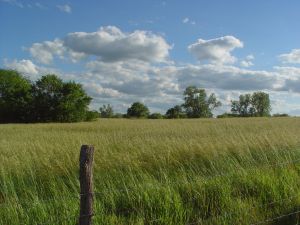Proponents of organic farming often begin with moral arguments, and the case for improved and retained soil fertility. Now comes more evidence that organic methods have the advantage of energy efficiency, too. The Land Institute of Salina, Kansas, has just published a study that measured, recorded and analyzed every input and output of energy of a 150-acre farm over the course of five years in the 1990’s. The original effort was intended to track and improve the farm’s sustainability, but this close accounting was also able to show that organic farming is in many areas more energy-efficient than conventional, chemical-based farming, even when the increased need for human labor is taken into account.
The study’s authors say they have included significant factors not measured in previous studies of farm efficiency, including supplies (whose energy use they found to be 15-27% of the total), equipment depreciation and the commuting energy use of farm workers (34-54% of the allotted labor energy numbers). Certain earlier studies included some of these factors, but none included all of them.
Some highlights:
- Beef production at the Kansas farm was almost twice as efficient as feedlot beef
- Egg production (the farm had 50 egg-laying hens) was also almost twice as efficient as battery caged production
- Wheat and sorghum were grown with significantly less energy
On the other side, raising broiler hens, oats and soybeans required higher energy use than conventional farming studies have shown (but see the caveat below). Also, the use of horses proved much less efficient than tractor use, given the amount of energy needed to grow the animals’ feed–though the authors point out the horses were underused by this farm, since they ate seven days and worked two. Given current fuel availability, the study finds that the greatest efficiency comes with organic methods used with modern gas-powered equipment. The farm’s methods included no irrigation, no chemicals, and wide use of nitrogen-fixing legumes and green manures for the crops, plus free-ranging chickens and intensive grazing management for the cattle.
Finally, the authors observe that the amount of energy use ignored by previous studies significantly throws off their data, and that measuring this energy would (among other things) “overwhelm the putative greenhouse gas or energy advantages claimed for many crop-based biofuels.” This basic point is one that can’t be made often enough: that some scientific arguments on energy use are based on data that do not take enough factors into account. If this study accomplishes nothing else but to show us we must think more carefully about less-obvious energy use when computing true energy costs, it has done a lot.
To read the study yourself, jump here. To learn more about The Land Institute, go here.












Does the study include the distribution side? When dealing with the transcontinental cabbage, grown in Washington and consumed in Texas, the energy and other costs must be considered. Another line of inquiry is whether the energy consumed is equal to the calories produced.
Good questions, but beyond the scope of this study. This was a look at energy use in the production of food–once known as farming.
All agriculture was organic until 150 years ago. It seems only natural to assume that all agriculture will be organic again, once it becomes too expensive or problematic to rely on cheap imported oil to get our transcontinental and transoceanic foodstuffs.
Do we really want to rely on coal plants or nuclear reactors to produce nitrogen based fertilizers and electric tractors? I can’t see it.
A couple of quick comments on the study, which I was reading with my lunch. I hope to be able to study it more later.
The study doesn’t seem to compare organic farms with other agriculture so much as it compares one particular 60 ha organic farm with other agriculture.
That item about energy for commuting has me especially puzzled. How is that a comparison between organic and non-organic farming? If it really is something intrinsically related to organic, it’s an interesting topic in itself. But I haven’t found the connection yet.
(Related research on these topics is done by a lot of people at my workplace. In fact, I think one of the new people down the hall worked at the Land Institute before coming here.)
BTW (and this is somewhat off-topic, but I like an excuse to point it out) I am old enough to remember the days when it was the right-wing kooks rather than the left-wing ones who were the organic growers and all-around environmentalists.
I still haven’t gotten around to re-reading that Land Institute publication further, but it’s really not a publication. It’s a pre-publication paper at best. The web site you sent us to is called “NaturePrecedings : Prepublication research and preliminary findings.”
I doubt that paper would get very far as is if it went through the peer review process. And I am not the only person who thinks the methodology is lacking. There is a commenter who seems to know about these things who also says so.
It’s an important topic and it’s good that the people are looking into all these factors that go into our efficiency calculations. But you can’t base very much in the way of sweeping conclusions on calculations taken on the management of a single 60ha farm in Kansas with only 20 of the 60ha in crops. What they can accomplish with that is what they set out to do in the first place. But this farm hardly represents “Organic” or anything else.
That “commuting” factor still has me scratching my head.
Comments are closed.